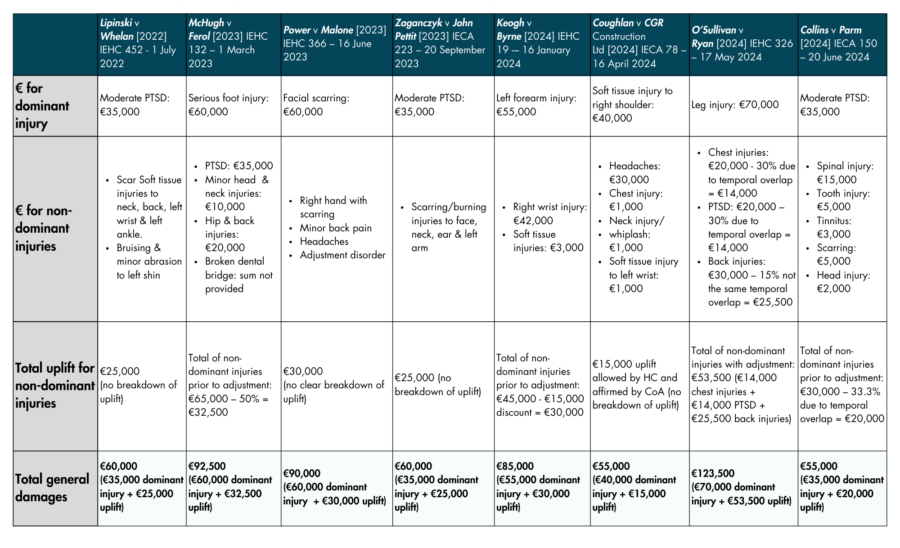Calculating Damages for Multiple Injuries Under the Personal Injuries Guidelines
Calculating general damages under Ireland's Personal Injuries Guidelines is not straightforward when multiple injuries are involved, which is often the case in medical negligence cases. Courts must balance compensating for each injury while ensuring the total award remains fair and proportionate. A "dominant injury" is identified and an "uplift" is applied to account for additional injuries. Recent court decisions highlight the diverse methods of calculation of general damages. Our Medical Law team explores these approaches and offers insights into how damages are calculated.
The Personal Injuries Guidelines set out ranges of monetary sums or damages for compensating certain categories of injury. The process of determining the level of compensation is usually simple where just one injury is sustained. However, many cases can involve multiple injuries. This is particularly true in medical negligence claims. The cornerstone of the Guidelines is to ensure plaintiffs are ‘fairly and justly compensated’ by an award which is ‘proportionate and just’.
Computing the ‘uplift’
When assessing multiple injuries, it is necessary to identify the “dominant injury” and its suitable level of damages under the Guidelines. Once the dominant injury is determined, the other “non-dominant” injuries are considered. The Court will then apply an “uplift” to the value of the dominant injury to reflect the impact of the other injuries sustained by the claimant.
Recent High Court and Court of Appeal judgments have illustrated that this is not a settled science.
Mr Justice Coffey in a case entitled Lipinski v Whelan quantified damages for the dominant injury. The judge then applied a further cumulative uplift regarding other injuries sustained, without providing a breakdown of the level of damages allowed for each of the non-dominant injuries.
In a separate case, McHugh v Ferol, an overall discount was applied to the total value of the non-dominant injuries to reflect the temporal overlap of the injuries. In this instance, the Court did provide a breakdown of the level of damages allowed for each of the non-dominant injuries. More recently, in O’Sullivan v Ryan, varied discounts were applied from the outset to the level of damages for each of the non-dominant injuries to reflect that some injuries shared the same temporal period, while the effects of others lasted beyond it.
Other matters to bear in mind when computing damages for multiple injuries
‘Reality check’
The Court of Appeal in Zaganczyk v John Pettit Wexford Unlimited Company emphasised that there should be a comparison of the overall award to other individual categories set out in the Personal Injuries Guidelines. If the total award exceeds the value of an award for a more serious injury, that should act as a “reality check” and trigger a recalculation to ensure the award is proportionate. The Court of Appeal reduced the total general damages from €90,000 to €60,000 for a post-traumatic stress disorder (PTSD) dominant injury. It noted that severe neck injuries, which may require spinal fusion and involve significant permanent disability, are valued between €70,000 and €100,000 under the Personal Injuries Guidelines, and this acted as a reality check.
Where the cumulative effect of the injuries is worse than an individual injury
In Keogh v Byrne, the High Court emphasised that applying an uplift is secondary to the trial judge's duty to "fairly and justly" compensate the plaintiff for all injuries. The award must remain "just and proportionate." This requires the judge to step back from assessing individual injuries and their assigned values to holistically evaluate the cumulative impact on the plaintiff. In certain cases, the combined effect of multiple injuries may be more severe than the sum of each injury alone. The example provided is where a plaintiff suffers injuries to both eyes resulting in total blindness.
Comparison of different methods of computing damages for multiple injuries
From these judgments, it is apparent that there is not one simple formula that can be used for the calculation of damages of multiple injuries. Generally, the dominant injury is identified, and an uplift is applied for the non-dominant injuries. The Courts have used different methods when calculating an uplift:
- By making a deduction from the damages that are tallied for the non-dominant injuries, or
- By making an initial deduction to each of the non-dominant injuries
In these scenarios, the deductions can be expressed as a percentage or by a specified sum. Set out and available to download below is a helpful quick reference guide, which provides a comparison of some of the methods used by the Courts.

Conclusion
Although different methods of adjustment exist, the Courts have noted that they hold little practical significance, as long as the final award of general damages is calibrated to ensure overall fairness and proportionality in compensating a person who has sustained multiple injuries. There may be additional methods employed by the Courts, particularly in cases where multiple dominant injuries exist, and it is difficult to determine which is the most significant — a common scenario in medical negligence claims. In addition, the Guidelines do not cover all complex injuries, such as damage to organs or vessels, frequently encountered in treatment for underlying medical conditions or injuries. It remains to be seen how the Courts will address multiple injuries in future medical negligence cases, and we await further developments with interest.
For more information and expert advice on defending claims, contact a member of our Medical Law team.
People also ask
What is an ‘uplift’ in a personal injuries award? |
An ‘uplift’ arises after a court considers a sum of damages to allow for the ‘dominant injury’ sustained by a plaintiff and increases that award for any other injuries that the plaintiff incurred. |
How are damages for multiple injuries under the Personal Injuries Guidelines Ireland calculated? |
There is not one simple formula that can be used for the calculation of damages for multiple injuries that come within the remit of the Personal Injuries Guidelines. Generally, the dominant injury is identified, and an uplift is applied for the non-dominant injuries. The Courts have used different methods when calculating an uplift: - By making a deduction from the aggregate of the non-dominant injuries; or - By making an initial deduction to each of the non-dominant injuries. In these scenarios, the deductions can be expressed as a percentage or by a specified sum. |
How to calculate damages when there is more than one significant/dominant injury? |
It remains to be seen what method of calculation the Courts take to assess an award where there is more than one dominant injury and it is not possible to identify which one is the most significant. |
The content of this article is provided for information purposes only and does not constitute legal or other advice.
Share this:





